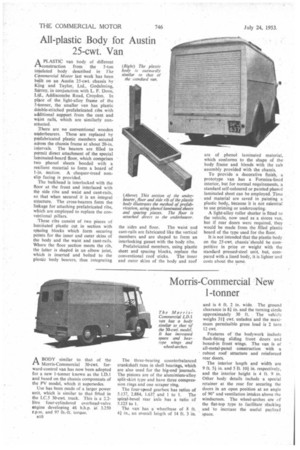All-plastic Body for Austin 25-cwt. Van
Page 44

If you've noticed an error in this article please click here to report it so we can fix it.
APLASTIC van body of different construction from the 5-ton insulated body described in The Commercial Motor last week has been built on an Austin 25-cwt. chassis by King and Taylor, Ltd., Godalming, Surrey, in conjunction with L. F. Dove, Ltd., Addiscombe Road, Croydon. lit place of the light-alloy frame of the 5-fonner, the smaller van has plastic double-stitched prefabricated ribs with additional support from the cant and waist rails, which are similarly constructed.
There are no conventional wooden underbearers. These are replaced by prefabricated plastic members secured across the chassis frame at about 20-in. intervals. The bearers are filled to permit direct attachment of the special laminated-board floor, which comprises two phenol sheets bonded with a resilient material to form a board of 1-in. section. A chequer-tread nonslip facing is provided.
The bulkhead is interlocked with the floor at the front and interlaced with the side ribs and waist and cant-rails, so that when secured it is an integral structure. The cross-bearers form the linkage for attaching prefabricated ribs, which are employed to replace the conventional pillars.
These ribs consist of two pieces of laminated plastic cut in section with spacing blocks which form securing points for the inner and outer skins of the body and the waist and cant-rails. Where the floor section meets the rib, the latter is shaped in an elbow joint, which is inserted and bolted to the plastic body bearers, thus integrating the sides and floor. The waist arid cant-rails are fabricated like the vertical members and are shaped to form an interlocking gusset with the body ribs.
Prefabricated members, using plastic sheet and spacing blocks, replace the conventional roof sticks. The inner and outer skins of the body and roof are of phenol laminated material, which conforms to the shape of the body frame and blends with the cab assembly provided with the chassis.
To provide a decorative finish, a prototype van has a Formica-lined interior, but for normal requirements, a standard self-coloured or painted phenol laminated sheet can be employed. Time and material are saved in painting a plastic body, because it is not estential to use priming or undercoating.
A light-alloy roller shutter is fitted to the vehicle, now used as a stores van, but if rear doors were required, they would be made from the filled plastic board of the type used for the floor.
It is not intended that the plastic body on the 25-cwt. chassis should be competitive in price or weight with the standard pressed-steel unit, but, compared with a lined body, it is lighter and costs about the same.




























































































